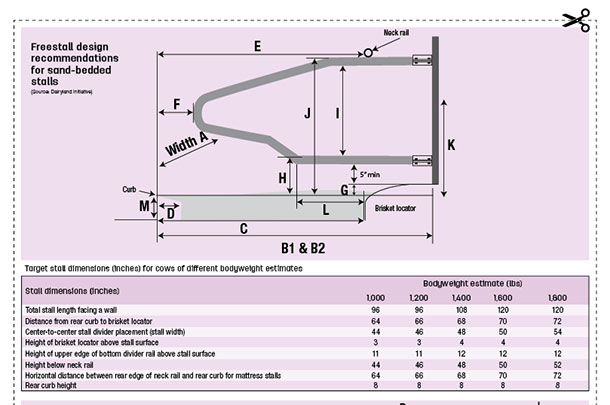’Twas the night before New Year, and all through the farm Not a milker was stirring, as they were all home. I rose in the morning,
facing a chore long forgot,
Milking my cows;
it will be simple, I thought.
As I moved the herd to the parlor,
there arose such a clatter,
A bang, and a slam, and a groan. What’s the matter?
I looked all around,
and to my amazement I saw
Cows struggling to rise
in each of their stalls.
Many producers do milk their own cows. Many others have milkers and staff. Regardless, it is important to look and listen when you’re in the barn. What should we see and hear?
Simply put, we should hear nothing.
Achieving silence through stall design
The most important distinction I like to make when recommending dimensions for freestall design is this: Build the stalls to fit the best cows in your herd, not your herd average.
Your best cows are often the biggest cows in the herd, so it naturally follows that the stalls should be a comfortable, larger fit to accommodate those cows. If you fit your stall to the average cow, then the chances of achieving anything more than average performance will be difficult.
And you’ll be limiting the possibilities for your best cows, not to mention they’ll be banging around trying to get in and out of stalls that are too small.
To keep the barn quiet, build it for the best cows, and the barn will be quiet.
Research the numbers
I have spent many years looking at research studies available from multiple sources to understand stall design. In recent years, stall width, neck rail height and stall length recommendations from study to study are fairly consistent, falling within an inch of one another.
Researchers have observed, watched videos, measured stalls, weighed cows, measured cows and tracked their performance over and over. The numbers really hone in on what is going to be comfortable.
We have put together a chart that takes a number of recent stall dimension articles and recommendations to help producers really see the hard numbers in stall design.
It includes our recommendations for stalls with concrete bases (i.e., water beds and mattresses), as well as the Dairyland Initiative’s recommendations for sand-bedded stalls (click here or on the image above to veiw it at full size in a new window). Take this chart – and take any other article or study that has caught your attention – and put the numbers to the test.
Go find what you want to see
With the numbers in hand, visit multiple new barns and compare the dimensions you have researched with what is actually in application at newly built facilities.
Do not just go to one barn; go to multiple barns on multiple days and look at the cows. Do you like what you see in the barn? Do you like what you hear? How does what you are seeing compare with the stall sizes in that barn? Do they have the same breed as yours?
Do not quit looking until it is clear in your mind that dimensions you are going to use are going to result in what you want to see in your own cows, based on research.
Don’t shortcut planning
No matter where in North America you live, there are going to be seasonal changes. Some days will be extremely hot, others extremely cold, some very windy, some very wet. As you visit barns, go back again and again in different weather conditions. Will the seasonal changes in climate make a difference in the design of your stalls?
Think about the future
We sometimes talk to producers that are ready to build a barn for their best cow, but then they realize they could get more stalls in the barn with just half-an-inch less in width or length – and then maybe a full inch. And suddenly the conversation changes.
Don’t think about how many cows you’ll be milking in the next year when the barn is done; think about the next 10 years and what has happened the past 10 years. Is your cow size getting larger overall? Are your best cows giving you more lactations or more milk, and what happens if all of your cows start improving with genetics?
You don’t want to limit your potential or the cows’ potential by trying to squeeze in a few extra stalls in the short term, compromising your future.
Talk with industry experts. Ask them what they see happening to cow size 10 years from now. What is the trend? Will it continue? Should you consider a different breed or mix? Go to seminars. Read articles.
If you follow this process of research and learning, you may be planning your new barn for two years before a single yard of dirt is moved, but it will be worth it to get the results you want.
What does a comfortable stall look like?
In every barn you visit, notice the cow as it stands in the stall. Notice the cow going to the lying position and getting back up. In a comfortable stall, you will see quiet, calm cows.
How to know a stall is comfortable
- Can the cows get up and down with ease?
- Does the cow keep shifting and repositioning itself as it drops or rises?
- Does the cow seem to have adequate room to lie and rise in one movement, or does it have to keep repositioning in small increments to get up and down?
- Do you hear banging?
- Do you hear sounds of struggling or sighs or groans?
Stall width
It was common 20 years ago to see 45-inch-wide stalls for Holsteins, and today that is unheard of. Most recent studies agree that Holstein herds need a 48-inch-wide stall.
But as the trend for larger cows continues and the focus on cow comfort increases, more and more recommendations are being made for 50-inch stalls.
How to choose your stall width
- If you have a herd of Holsteins now, do you envision going to more crosses or changing breeds altogether?
- Do the industry people you talk to see a trend of cows continuing to get bigger, or do they see cows being bred for efficiency, resulting in a smaller cow?
- Are the cows you are observing of the same size and weight of your cows and of cows you envision in your herd 10 years from now?
- In barns you visit, what do the largest cows look like? How do they act? How wide are their stalls?
- Ask the producer about the lactation average of the herd and the lactation average of the best cows. Is it above or below the 2.4-year North American average, and does that stall width number seem like a good fit?
Stall length
The length of your stalls will have a good deal to do with the overall width of your barn. Too many times, producers look at the project budget and see an “easy” way to cut costs by reducing stall length or alley width.
By visiting different farms, you’ll begin to see that investment in a wider barn will pay off.
How to choose stall length
- What does a cow’s lunge motion look like in a 16-foot head-to-head stall, an 18-foot head-to-head stall, a 9-foot sidewall stall and a 10-foot sidewall stall?
- What does its breathing and resting head space look like?
- How close is it to another cow’s head?
- Observe the cow’s demeanor as it lies down, gets up and as the adjacent stalls are filled.
- Visit the stall on the warmest day possible, and observe the difference in the air flow in a narrower barn.
Neck rail height/diagonal
Positioning the neck rail is very important. The diagonal measurement from the neck rail to the rear curb is critical. This dimension tells us that the cow has room to stand straight in the stall, so when it drops down and gets up, it can execute those motions with its body straight without twisting or turning awkwardly.
How to know the neck rail is positioned correctly
- When the cows get up, do they bang their necks?
- Do the cows have marks on their necks?
- Are the cows lying straight in their stalls?
Loop dimensions
Two critical dimensions to watch for in loop designs are the head opening and the bottom rail length. The cow needs an opportunity to lunge sideways in the stall. If the head opening is too small, it will not be able to rise comfortably sideways, or it will adapt. Neither is a good option.
Brisket locator position
Cows do not naturally know how to lie in a freestall. The various hardware helps guide them. The brisket locator specifically tells the cow where to stop to avoid moving too far forward in the stall.
It’s critical to install a brisket locator so the cow knows exactly where to lie to keep it from soiling the end of the stall or from banging its neck on the neck rail.
How to choose a brisket locator location
- Do the cows bang on the neck rail, even though the neck rail measurement is correct? It may be the brisket locator is too far forward – or there is no locator.
- Observe the manure piles in the stalls. Are they excessive? Are they created because the cow is laying too far forward?
- Remember to observe the later-lactation cows most carefully. There will always be some manure piles as cow sizes differ, but it’s much better to clean stall ends a few more times a day than it is to bang up the later-lactation cows.
Stall dimensions: By the numbers
I am not here to suggest that these numbers are the absolute best, or that they will not change as the industry and the cows change. I do, however, see stall dimension particulars that deserve special attention when building a barn today. ![]()

-
Dean Throndsen
- President
- ACT Inc.
- Email Dean Throndsen







